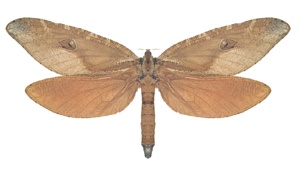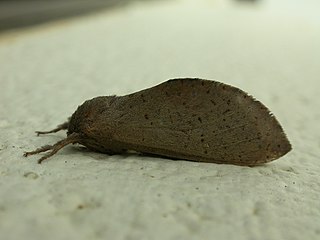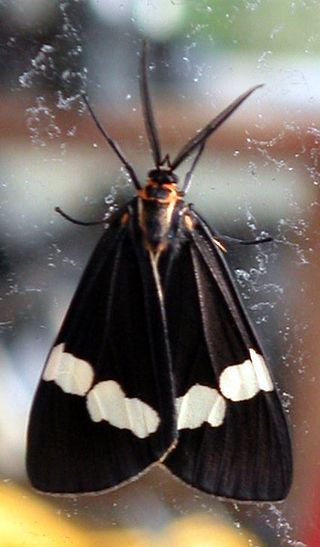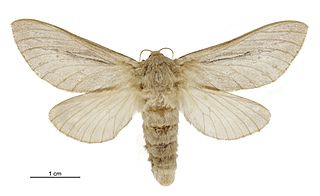
The Hepialidae are a family of insects in the lepidopteran order. Moths of this family are often referred to as swift moths or ghost moths.

Wiseana is a genus of ghost moths, collectively known as porina, of the family Hepialidae. There are seven described species, all endemic to New Zealand. Some species of this genus are a major pest in New Zealand exotic pastures. It is impossible to distinguish species at the larval/caterpillar stage without DNA technology, however adult porina moth species can be visually distinguished.

Zelotypia is a monotypic moth genus of the family Hepialidae. The only described species is Z. stacyi, the bentwing ghost moth, which is only found in Queensland and New South Wales, Australia. This is a very large species with a wingspan of up to 250 mm. The larva feeds and pupates in the trunks and branches of Eucalyptus.

Elhamma australasiae is a moth of the family Hepialidae. It is found along the eastern seaboard of Australia.

Abantiades latipennis, known as the Pindi moth, is a species of moth in the family Hepialidae. It may also be referred to as a swift moth or a ghost moth, as this is a common name associated with Hepialidae. Endemic to Australia and identified in 1932, it is most populous in temperate rainforest where eucalypti are prevalent, as the larvae feed primarily on the roots of these trees. Females lay eggs during flight in a scattering fashion. The larvae live for over eighteen months underground, while adult moths survive for approximately one week, as they have no mouthparts with which to feed. The moths are preyed upon by a number of predators, including bats and owls. Brown in colour overall, males are paler and the identifying silver bars of the male's wings are more prominent than those of the female's, with dark margins. Male adults are generally smaller.

Nyctemera annulata, the magpie moth, is a moth of the family Erebidae. The species was first described by Jean Baptiste Boisduval in 1832. It is endemic to New Zealand and found in all parts of the country.

Aoraia enysii, also known as the forest ghost moth is a species of moth of the family Hepialidae. It is endemic to New Zealand. This is the only species of the genus Aoraia that can be found in the North as well as the South Island. This species can be found from Mount Te Aroha southwards. This species was described by Arthur Gardiner Butler in 1877 from a specimen obtained in the North Island by J. D. Enys.

Dioxycanus fusca is a species of moth of the family Hepialidae. It is endemic to New Zealand. This species was first described by Alfred Philpott in 1914 as Porina fusca using specimens collected by C. Fenwick and M. O. Pasco. In 1966 L. J. Dumbleton reviewed New Zealand Hepialinae and placed this species within the genus Dioxycanus, giving it the new combination Dioxycanus fuscus.

Dioxycanus oreas is a species of moth of the family Hepialidae. It is endemic to New Zealand. It was first described by George Vernon Hudson in 1920. The species was discovered by Averil Lysaght.

Dumbletonius characterifer is a species of moth of the family Hepialidae. It is endemic to New Zealand. It was first described by Francis Walker in 1865.

Dumbletonius unimaculatus, also known as the forest ghost moth, is a species of moth of the family Hepialidae. It is endemic to New Zealand. This species is host to the vegetable caterpillar fungus Ophiocordyceps robertsii.

Wiseana copularis is a species of moth belonging to the family Hepialidae. It is endemic to New Zealand. This moth is one of several very similar looking species within the genus Wiseana and this group are collectively referred to as "Porina" moths. In its larvae form this species consumes pasture grasses and, if numerous, is regarded as a pest by New Zealand farmers reliant on good quality pasture for their stock.

Wiseana fuliginea is a species of moth belonging to the family Hepialidae. It was described by Arthur Gardiner Butler in 1879 and is endemic to New Zealand.

Wiseana jocosa is a species of moth belonging to the family Hepialidae. It was described by Edward Meyrick in 1912 and is endemic to New Zealand.

Wiseana mimica is a species of moth belonging to the family Hepialidae. It was described by Philpott in 1923, and is endemic to New Zealand.

Wiseana signata is a species of moth belonging to the family Hepialidae. It was described by Francis Walker in 1856 and is endemic to New Zealand.

Wiseana umbraculata, also known as the bog porina, is a species of moth belonging to the family Hepialidae. There are seven endemic species and three haplotypes of Wiseana in New Zealand including bog porina. It was regarded as being common in Whanganui in the early twentieth century.

Asaphodes dionysias is a species of moth in the family Geometridae. This species is endemic to New Zealand and is only known from mountainous areas in Central Otago. It lives in open grassy mountainous habitat at altitudes up to 1750 m. It is also known to live in wetland habitat. The larvae of this species feed on native herbs. The adults of this species are on the wing in January and February. The adult female of the species has reduced wing size in comparison to the male.

Sweet potato cultivation in Polynesia as a crop began around 1000 AD in central Polynesia. The plant became a common food across the region, especially in Hawaii, Easter Island and New Zealand, where it became a staple food. By the 17th century in central Polynesia, traditional cultivars were being replaced with hardier and larger varieties from the Americas. Many traditional cultivars are still grown across Polynesia, but they are rare and are not widely commercially grown.

Scythris nigra is a species of moth in the family Scythrididae first described by Alfred Philpott in 1931. It is endemic to New Zealand. The larvae of this species feeds on Hebe odora. The adults are day flying and on the wing in December.





















